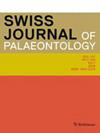New insights into the early morphological evolution of sea turtles by re-investigation of Nichollsemys baieri, a three-dimensionally preserved fossil stem chelonioid from the Campanian of Alberta, Canada
IF 2.2
2区 地球科学
Q1 PALEONTOLOGY
引用次数: 0
Abstract
The early evolution of Pan-Chelonioidea (sea turtles) is poorly understood. This is in part due to the rarity of undeformed skulls of definitive early stem chelonioids. In this work, we redescribe the holotype of Nichollsemys baieri using µCT scans and segmentations of the skull. This fossil is the best 3D preserved skull of any Campanian sea turtle, and includes partial “soft tissue” preservation. Nichollsemys is morphologically similar but clearly distinct from Toxochelys spp., and both show a mosaic of plesiomorphic and derived chelonioid features. The internal cranial anatomy documents the presence of derived characters in Nichollsemys baieri that are absent in Toxochelys spp., such as the loss of the epipterygoids and the rod-like shape of the rostrum basisphenoidale. Among the numerous plesiomorphic characters is the presence of a splenial bone, which was unnoticed before. An updated phylogenetic analysis retrieves Nichollsemys baieri as a non-protostegid early stem chelonioid in a slightly more crownward position than Toxochelys latiremis. Our phylogeny includes macrobaenids and protostegids as pan-chelonioids, and we find unorthodox results for dermochelyids. Thus, although Nichollsemys baieri provides important new insights into the early morphological evolution of sea turtles, much work remains to be done. As a completely 3D preserved specimen, we included Nichollsemys baieri into a recent landmark-based skull shape dataset of turtles. Morphospace analysis reveals an intermediate position between cryptodires and crown chelonioids. Based on these data, we also predict that Nichollsemys baieri was still capable of neck retraction, constraining the loss of this trait to more crownward pan-chelonioids.通过重新研究加拿大阿尔伯塔省坎帕尼亚期三维保存的茎螯类化石 Nichollsemys baieri,对海龟早期形态演化的新认识
人们对海龟(Pan-Chelonioidea)的早期演化知之甚少。这部分是由于确定的早期干海龟类的未变形头骨非常罕见。在这项研究中,我们利用 µCT 扫描和头骨分割重新描述了 Nichollsemys baieri 的主模式。该化石是所有坎帕尼亚海龟中三维保存最好的头骨,包括部分 "软组织 "的保存。Nichollsemys 在形态上与 Toxochelys 类似,但又明显有别于 Toxochelys,两者都显示出多形性和衍生的螯足类特征。头颅内部解剖结构表明,Nichollsemys baieri 存在着 Toxochelys spp.所不具备的衍生特征,如上翼的缺失和喙基鼻的杆状形状。在众多同形特征中,脾骨的存在是以前从未注意到的。经过更新的系统发生分析,Nichollsemys baieri被认为是一种非原栉水母类的早期茎栉水母类,其位置比Toxochelys latiremis稍稍靠后。我们的系统发育包括了作为泛螯足类的大鳞螯足类和原螯足类,我们发现鳞螯足类的系统发育结果并不正统。因此,尽管 Nichollsemys baieri 为海龟的早期形态演化提供了重要的新见解,但仍有许多工作要做。作为一个完全三维保存的标本,我们将 Nichollsemys baieri 纳入了最近基于地标的海龟头骨形状数据集中。形态空间分析表明,Nichollsemys baieri介于隐翅类和冠螯类之间。基于这些数据,我们还预测 Nichollsemys baieri 仍然能够缩颈,从而限制了更多冠状泛长尾龟丧失这一特征的可能性。
本文章由计算机程序翻译,如有差异,请以英文原文为准。
求助全文
约1分钟内获得全文
求助全文
来源期刊

Swiss Journal of Palaeontology
Earth and Planetary Sciences-Paleontology
CiteScore
4.30
自引率
16.70%
发文量
17
审稿时长
4 weeks
期刊介绍:
The Swiss Journal of Palaeontology publishes original research and review articles of interest to the international community in the fields of palaeontology, taxonomy and systematics, while recognising at the same time the importance of documenting high-quality palaeontological data in a regional context. Palaeobiology in combination with alpha taxonomy is a core topic of the journal.
Submitted papers should have an appeal as wide as possible, directed towards an international readership. Contributions should not have been simultaneously submitted elsewhere, and the overlap of content between related articles should be minimal. Duplications of text and the use of previously published illustrations without adequate citation are unacceptable. If a manuscript has two or more authors, both or all have to sign to confirm they all were involved in the work and have agreed to its submission. The preferred manuscript language is UK English, but consistently used US English is also acceptable. We encourage the publication of proceedings of international meetings as well as special thematic issues. Short contributions and book reviews are also accepted.
An international editorial team as well as guest editors guarantee that the thematic issues as well as all articles in regular issues are peer-reviewed and meet the highest standards.
 求助内容:
求助内容: 应助结果提醒方式:
应助结果提醒方式:


